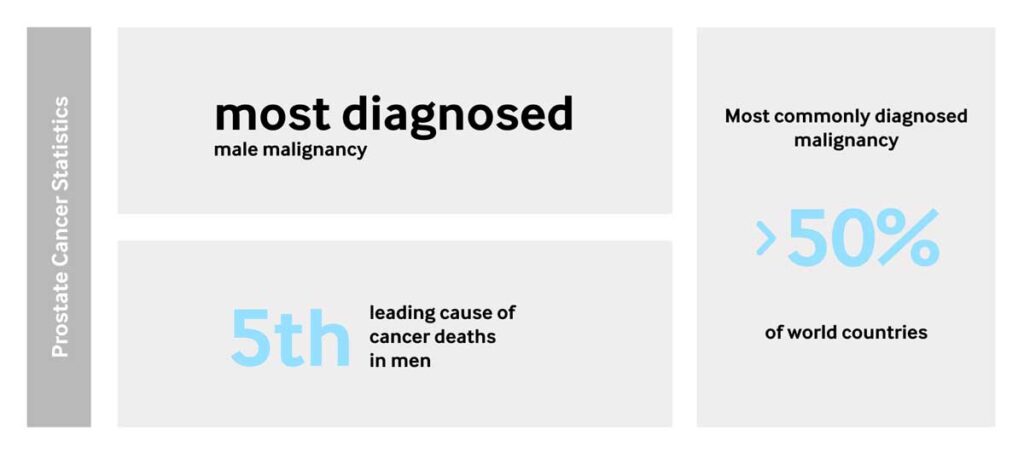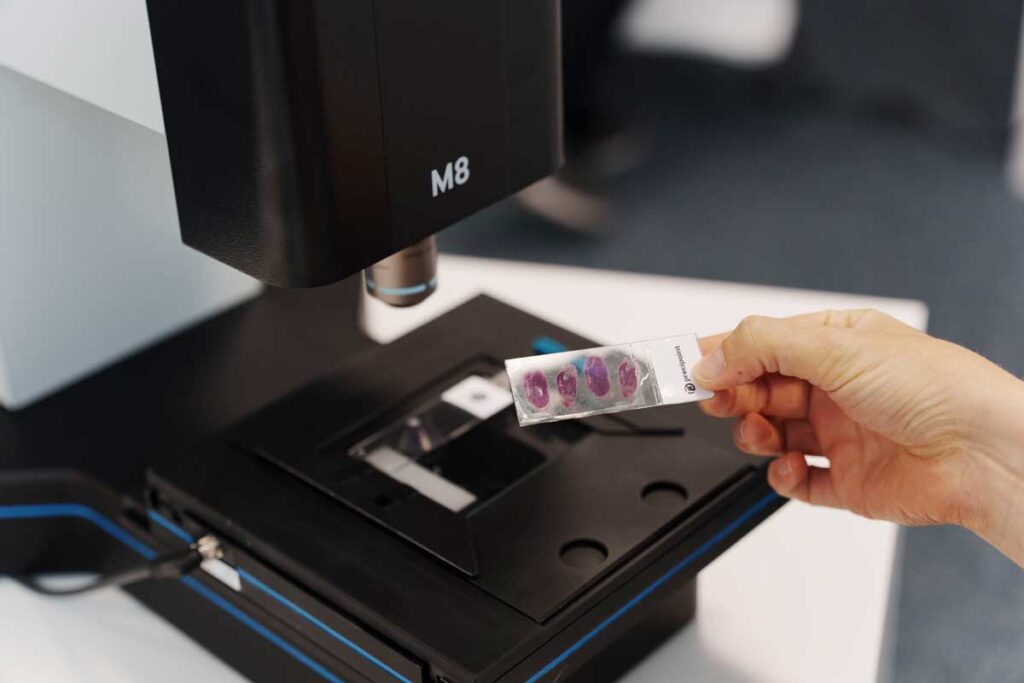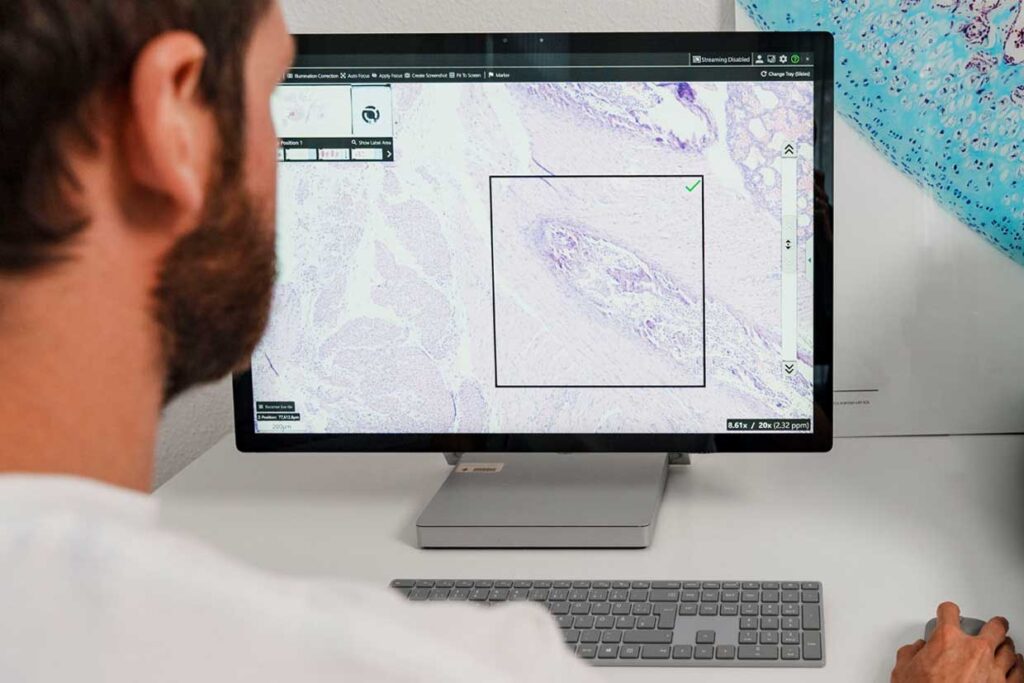September is Prostate Cancer Awareness Month, the right time to delve into its fundamentals and discover the latest breakthroughs in its treatment, including the groundbreaking advancements in digital pathology. Prostate cancer ranks among the most prevalent malignancies, especially in developed nations, and its presence is often detected through the prostate-specific antigen test. With this test, pathologists can get efficient and precise results in the early phases of the illness leading to improved treatment. Undoubtedly, this test has significantly contributed to reducing mortality rates linked to this formidable illness. Yet, prostate cancer remains a leading global cause of death, necessitating urgent action and heightened awareness to tackle the challenge head-on. The solution lies in fostering greater awareness to minimize mortality rates as much as possible. In this article, we will explore the core characteristics of prostate cancer and then delve into the transformative impact of digital pathology on modern treatment approaches, crucial for the fight against prostate cancer.
September: Prostate Cancer Awareness Month
September
is the time when the spotlight shines on Prostate Cancer Awareness, aiming to
raise public consciousness about this significant health concern. Prostate
cancer is the most common non-skin cancer diagnosed in men, and the second
leading cause of cancer deaths in men, after lung cancer. In September, many
medical institutions, organizations, health departments, and government
organizations take measures to remind and educate people and experts on what
can be done to solve this leading health problem in the world. Knowledge about
it is a must!

Prostate Cancer: Diagnostics and Treatment
Prostate cancer is a prevailing health challenge affecting men, particularly in the developed world, with its prevalence making it one of the most encountered health concerns in the male population. Prostate cancer can be determined by prostate cancer screening serum, or more precisely, prostate-specific antigen tests (PSA). By using the screening serum, prostate cancer mortality has decreased in recent years. In low-risk prostate cancer screening, numerous men require immediate intervention. Surgical and radiation methods continue to serve as the cornerstone approaches for managing localized prostate cancer, representing the primary and most established treatment modalities. For more advanced cases, systemic treatments are used, based on targeting androgen signaling. Furthermore, Taxane chemotherapy and poly (ADP-ribose) polymerase (PARP) inhibitors are emerging as treatment options for castration-resistant prostate cancer. The prostate gland is enveloped by crucial delicate nerve tissue responsible for controlling erections, a key factor in preserving potency. By meticulously separating this intricate network of nerves from the prostate during surgery, it’s often possible to maintain the capacity for erections in the majority of cases.
Stay Ahead with Insights from Precipoint!
Welcome to our newsletter! Be the first to know about our latest products, services, webinars, and happenings in PreciPoint. Don't miss out on this opportunity to stay informed. Subscribe to our newsletter today!
By clicking “Subscribe”, you agree to our privacy policy.
Symptoms and Diagnosis
Worldwide, prostate cancer is the most diagnosed male malignancy and the fifth leading cause of cancer death in men. Globally, prostate cancer is the most commonly diagnosed malignancy in more than 50% of world countries. Since 2020, a staggering number of newly diagnosed cases, reaching 1,414,249, coupled with approximately 375,000 lives lost globally, stand as a grim testament to the profound impact of prostate cancer on a global scale. Fortunately, most prostate cancers tend to grow slowly and are low-grade with relatively low risk and limited aggressiveness. In most cases, there are no initial symptoms, so most patients are unaware of the future crisis. Late symptoms may involve fatigue due to anemia, pain in the bone, paralysis from spinal metastases, and renal failure from bilateral ureteral obstruction. Diagnosis is primarily based on prostate-specific antigen (PSA) testing and transrectal ultrasound-guided (TRUS) prostate-tissue biopsies, although PSA testing remains controversial.

Risk Factors
The established primary risk factors for prostate cancer include age, ethnicity, obesity, and family history. The chances of prostate cancer tend to rise as individuals advance in age, while it is noteworthy that cancer aggressiveness generally diminishes with increasing age. Additional risk factors associated with prostate cancer encompass gender, positive family history, greater stature, obesity, hypertension, sedentary lifestyle, persistently elevated testosterone levels, exposure to Agent Orange, and specific ethnic backgrounds. While the exact cause of prostate cancer remains unclear, genetic factors are known to play a significant role. Patients with genetic predispositions or hereditary prostate cancer often exhibit an earlier onset of the disease, more rapid disease progression, and a higher likelihood of presenting with locally advanced tumors. Moreover, these individuals face an elevated risk of recurrence following surgical intervention.
Role of Digital Pathology in Prostate Cancer Treatment
Within the realm of prostate cancer diagnostics, digital pathology assumes a pivotal role, exerting a substantial influence on the accurate assessment and interpretation of prostate tissue samples. It enhances accuracy, efficiency, and collaboration among healthcare professionals. There are a few ways in which digital pathology is used in prostate cancer diagnostics.
1. Slide Scanning
Digital pathology in prostate cancer diagnostics involves preparing prostate tissue samples. These are prepared as thin sections on glass slides. These slides are then scanned using high-resolution digital scanners, converting them into digital images. The resulting digital slides can be stored electronically and accessed remotely.

2. Image Analysis
Digital Pathology platforms employ computer algorithms to analyze the digital slides automatically. These algorithms can identify and quantify various features of prostate cancer cells, such as their shape, size, and distribution patterns. A quick analysis of large data quantities can assist digital pathology experts in making more accurate and consistent diagnoses.
3. Telepathology
Digital pathology enables remote access and consultation and facilitates telepathology. Medical experts can share digital slides securely with other experts, regardless of their geographical location. This feature is extremely useful in areas where there is a lack of healthcare professionals. Remote consultation can lead to better diagnostic consensus and treatment decisions.
4. Second Opinions and Quality Assurance
Digital pathology facilitates second opinions because of the possibility for easy sharing of digital slides. This enhances accuracy and confidence, and the slides can also be used for training purposes. With iO:M8 Digital Live Microscope, your assessments become faster and more efficient. The digital microscope is used for intraoperative consultations and also works with frozen sections, Mohs, FNA, and more. Research indicates that in cases of prostate cancer, approximately 22% of instances reveal positive margins during a frozen section analysis. Remarkably, 92.3% of these positive margins can be successfully eliminated. This substantially reduces the likelihood of requiring follow-up surgery, which represents a substantial advantage for patients.

5. Digital Archiving and Retrieval
Digital pathology offers a modern alternative to storing physical slides, enabling the storage of prostate cancer images on digital platforms. This electronic storage reduces the risk of loss or damage and provides a very valuable resource for future research. PreciPoint’s PreciCloud represents an all-in-one virtual microscopy experience and allows you to work collaboratively from anywhere and anytime. Sharing and working on microscopy samples with your colleagues worldwide has never been easier.
6. Machine Learning AI Applications
Digital pathology platforms can integrate machine learning and artificial intelligence (AI) algorithms. They can learn from vast amounts of data, aiding in the detection and classification of prostate cancer cells. PreciAI transforms high-resolution image evaluation with digital microscopy and AI-powered image analysis solution. By adopting digital microscopes and AI at the same time, you can benefit from advanced features, increased accuracy, and precision, and achieve greater convenience. PreciAi helps you to automate and improve the image evaluation process.
Elevated prostate cancer awareness plays a paramount role in shaping effective treatment approaches for this malignancy, which is a prominent contributor to global mortality rates. Prostate Cancer Awareness Month presents an ideal platform for approaching this issue in a comprehensive and all-encompassing manner. Medical organizations often share a whole array of cutting-edge materials that unveil the latest trends in treating this formidable disease. Amidst the wealth of information, it’s vital not to overwhelm the public. The community needs to be empowered with essential insights that will be the tool for an effective fight against prostate cancer. It might fly under the radar without symptoms, so you need to do a detailed diagnosis. In some cases, symptoms like anemia or bone pain could appear. Although the causes of this illness remain enigmatic, certain factors such as male gender, obesity, or hypertension could heighten the risk. Thanks to prostate-specific antigen tests (PSA) and digital pathology, mortality rates have seen a dip. So, raising awareness is key to nailing this treatment game. Products and services from PreciPoint such as PreciAI, PreciCloud, and iO:M8 are winning the fight against this deadly disease.











